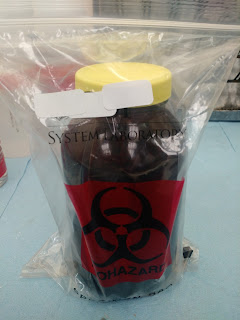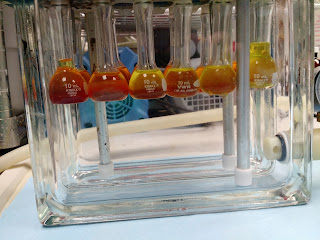My boyfriend works in a hospital lab.
Yes, we're both lab rats <3.
He comes home with stories that make me cringe. He's seen all sorts of tissues, body parts, organs, and fluids.
We've both worked in microbiology, but my work brings in samples such as municipality boil orders, whereas his sends down pieces of a toe or lung to the lab.
We have very different levels of tolerance.
Kudos to those of you that can work in hospitals!
My stomach turns at the thought of going in one. Sometimes we're fortunate enough to carpool together, and just pulling in a parking space at a hospital makes me so glad I'm not going in.
Kudos to those of you that can work in hospitals!
My stomach turns at the thought of going in one. Sometimes we're fortunate enough to carpool together, and just pulling in a parking space at a hospital makes me so glad I'm not going in.
My job has its own ups, downs, and dangers. Our lab is full of hazardous chemicals and carcinogens, but every now and then we get biohazardous samples.
My least favorite of any sample we receive is the annual test from the local hospitals. They are required to test for formaldehyde levels.
Formaldehyde among many other things is used in the embalming process.
Right after I started in SPE I received these formaldehyde samples, and my boss joked, "oh the dead body juices are in."
Ever since then I have been super disturbed by these "dead body juices" samples.
During the process of testing for formaldehyde we make and use a reagent called DNPH. It turns the samples yellow and leaves stains on our countertops.
When we're done we soak our glassware that is stained yellow.
After formaldehyde samples the dishwater smells like rotting corpses...or maybe that's just my imagination.
The last hospital sample we received even looked like dead body juices, and colored the tip of our syringe crimson.
I probably should have felt relief in the big biohazard label, but in actuality I was disgusted.
My least favorite of any sample we receive is the annual test from the local hospitals. They are required to test for formaldehyde levels.
Formaldehyde among many other things is used in the embalming process.
Right after I started in SPE I received these formaldehyde samples, and my boss joked, "oh the dead body juices are in."
Ever since then I have been super disturbed by these "dead body juices" samples.
During the process of testing for formaldehyde we make and use a reagent called DNPH. It turns the samples yellow and leaves stains on our countertops.
When we're done we soak our glassware that is stained yellow.
After formaldehyde samples the dishwater smells like rotting corpses...or maybe that's just my imagination.
The last hospital sample we received even looked like dead body juices, and colored the tip of our syringe crimson.
I probably should have felt relief in the big biohazard label, but in actuality I was disgusted.
The only good thing about formaldehyde samples is we get to use our favorite piece of equipment, the wrist action shaker.
I challenge someone to find an equipment name spawning better lewd jokes than wrist action shaker!
http://legismex.mty.itesm.mx/secc_inter/SW-846/8315.pdf
~~~~This is a link to a website that shows the kind of recipe we work with. This isn't from my work, and it's pretty old, but it gives you an idea of the methods we read. The method on the website is also for determining if formaldehyde is in a sample.
http://www.ewg.org/research/exposing-cosmetics-cover/formaldehyde-releasers#.WZtBhJBOm2c
http://www.ewg.org/research/exposing-cosmetics-cover/formaldehyde-releasers#.WZtBhJBOm2c















No comments:
Post a Comment